Recently, there have been developments in the world of low-latency wireless speaker systems for DJs, which mean that you can now feasibly DJ without wires from your DJ equipment to your loudspeakers, as well as link those speakers without wires.
Doing this can be convenient for quick set-up and breakdown, it can be great for safety (for instance, when setting up outdoors and running wires in places where people may trip up on them), and it offers more flexibility for DJs interested in more unconventional setups and locations.
In today’s world, where DJs are livestreaming from more and more extreme places, being able to set up a DJ system with wireless speakers can be easier and look more attractive on camera, too – especially when the rest of the system doesn’t require wires.
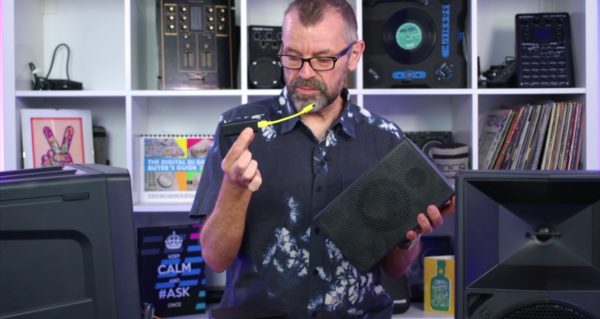
Fully battery-operated systems where the controller/standalone, laptop, speakers, headphones, lights and even livestream cameras and cellular router are all working without any wires connecting any of them to each other, except for maybe a short USB cable between a controller and laptop, are now fully possible.
Read this next: 5 Modern Technologies That Are Making Wireless DJing Possible
Of course, such set-ups do have downsides. The biggest one is that lots of batteries need to be charged, and potentially there are extra units in the set-up (as we’re going to see shortly) in order to transmit the signal between various parts.
But this kind of complete battery, wireless system is now a reality, and there is definitely a call for such set-ups – so here we’re going to round up three systems that we’ve tested at Digital DJ Tips.
What the three systems here have in common is:
- Ultra low-latency wireless, suitable for DJing
- Battery-powered
- Two units can be linked together wirelessly
They’re all different from each other though in meaningful ways, and they all have pros and cons. So if this is something you’ve been thinking about, here’s your chance to get up to speed with what’s on the market and choose which may be right for you. Note that we have in-depth reviews of all of these if you wish to dive in further, too.
Why not just use Bluetooth?
We use Bluetooth for everything else in our lives, don’t we? From our AirPods and party speakers to our computer keyboards and trackpads. So why not just use the Bluetooth tech that we’re all used to for DJing?
In a word, latency. Latency describes the gap between you doing something on your DJ gear and the results coming out of the speakers. With Bluetooth that can be as high as 250 milliseconds (or a quarter of a second).
This is far too high for DJing, when we really want to feel like anything we do happens instantly in the speakers. To achieve that you need to get down to 15 to 20 milliseconds of delay, which is something all of these systems operate within.
So your next question might be, why not use a Bluetooth speaker system (JBL, Bose etc) where I can press a “party mode” to link all the speakers together, and I’ll just wire my DJ controller to the “line in” on the first speaker in the chain?
Again, latency is the issue here, because not only will that same 250 milliseconds of latency be introduced when the speakers are talking to each other, but even when wired, such speakers STILL introduce latency! So those types of speakers are no-go for DJs in any set-up, wired or not.
So now we understand why bespoke wireless is necessary over Bluetooth, and we know the criteria for inclusion here, let’s look at the three systems we have in-depth knowledge of here at the Digital DJ Tips school.
Soundboks (with SKAA wireless)
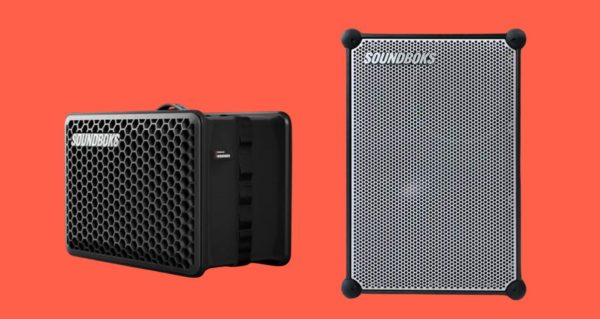
The first and oldest set-up here is the Soundboks range of speakers, with SKAA wireless.
SKAA is a third-party wireless tech, and although Soundboks is the only brand we’ve seen in the wild using this system, there are others on the way. Indeed, we recently covered the announcement of a subwoofer called Death From Below, made by the same company that makes SKAA – we’re looking forward to testing that.
Anyway, back to the Soundboks speakers, and they come in two sizes. The Soundboks 4, their biggest speaker, is pretty legendary for its volume and durability, a classic PA-style speaker in wood and rubber with a rugged grille. They also have a smaller version of it called the Soundboks Go. (Our review is of the Soundboks 3, but they’re very similar.)
All Soundboks speakers have the SKAA technology built in, meaning they can receive from any equipment that can transmit this format. They can also talk to each other with super-low latency. If this is the system you want to go for, your two options are:
- To wire your DJ controller or mixer to the first speaker, which you would typically have close to you. The second one talks wirelessly to the first one, saving you the need to run any long cables
- Buy a SKAA transmitter, which is a rugged box with an aerial on it that can be plugged into your DJ unit, and which contains a battery as well, that will transmit to the receiving Soundboks speaker, thus giving you complete wireless and allowing you to put both speakers any distance you wish from you
While we found the latency was a little noticeable on this system, we certainly didn’t worry about it when it came to DJing.
AlphaTheta Wave Eight (with SonicLink wireless)
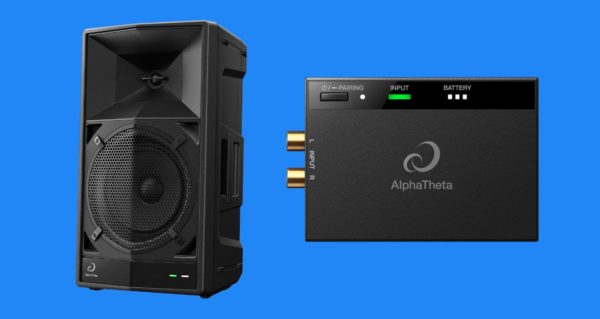
This is another PA-style speaker, although the build is very different, being a more modern, wedge-shaped plastic build than the Soundboks, and so much lighter, although still rugged, with a metal grille on the subwoofer.
The wireless system here is called SonicLink, which is AlphaTheta’s own system, and the unique selling point here is that each one of these speakers comes with a nested SonicLink transmitter. The cool bit is that this can be removed from its cubby hole in the speaker, and plugged into any source, or it can be left in the speaker, from where it can communicate with another Wave Eight speaker.
Read this next: AlphaTheta Wave Eight Portable DJ Speaker Review
It’s clever because – assuming you’ve got two of these speakers – you can remove the SonicLink transmitter from one of them and plug it into your source (for instance, a DJ controller or DJ mixer), which will then transmit to the speaker that you haven’t removed the SonicLink transmitter from, which in turn will use its nested transmitter to speak to the other one.
The advantage over the Soundboks set-up is that you don’t need a separate transmitter to have full wireless, i.e. no cable between your speakers or between your DJ controller and the nearest speaker, because one is already provided, making this arguably the simplest way here to get full wireless speakers as part of your set-up.
AIAIAI Unit 4 (with W+ wireless)
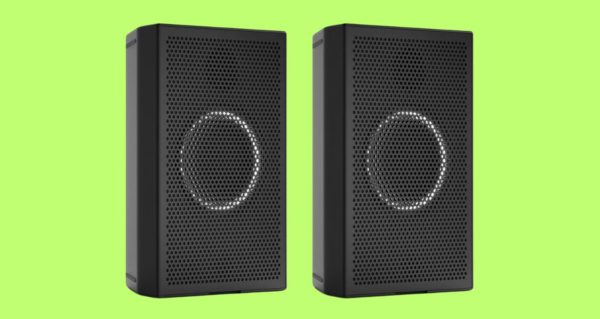
The AIAIAI Unit 4 speakers, which you can buy in a pair along with the W+ wireless transmitter that is needed to operate this system, are a very different beast from the other two.
These speakers are far smaller. Indeed, they’re smaller than most nearfield monitor speakers. Their primary intended use is as portable producer monitors, for use at home or when producing on the move. The idea is you plug the diminutive W+ USB-C transmitter into your laptop, which then communicates to the speakers wirelessly with ultra-low latency, meaning you don’t need an audio interface or cables from your laptop to the speakers.
However, the speakers are truly versatile. They have metal grilles, which can be magnetically clipped on or off. And when they’re clipped on, the speakers are rugged enough to use for (very small) parties. For this purpose, they also have a pole mount on the bottom, although it is the screw-in variety rather than the bigger professional mounting hole found on the other two speakers covered here.
On top of that, they can also be used in the classic horizontal wedge shape, so they could also be used (theoretically) as DJ monitors in a public environment, for instance when DJing in a bar that doesn’t provide monitoring.
While the transmitter itself uniquely can take both minijack and USB-C audio, it doesn’t contain a battery, so you would need a battery pack to plug into the transmitter if you wanted to plug the audio output from your mixer or controller into it directly.
Otherwise, assuming you were using a controller, you could plug it directly into your laptop – and as long as you can set your DJ software to output the master through the laptop – you can transmit your main output via the laptop to your speakers that way – a bit unusual but it works (we tried it).
Example set-ups with these speakers
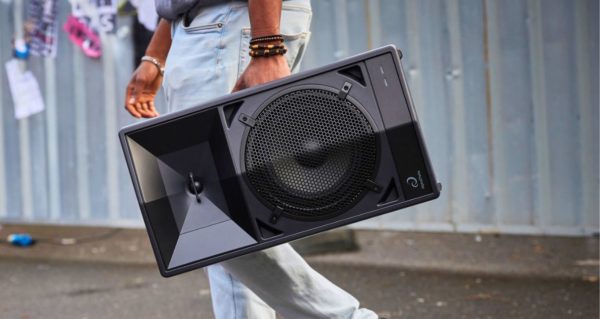
With the Soundboks and Wave Eight, you’re talking movable rather than portable. These are substantial units, and so you’ll probably be carrying them around in the boot of a car. In such set-ups you may even be carrying a generator with you if you’re going to DJ somewhere without mains electricity, and so in that case, any DJ gear is going to work fine. You’ll just have to be sure that the transmitters themselves are charged before your gig.
DJ like a pro using ANY gear: The Complete DJ Course
With the Unit 4 speakers, though, they’re truly portable. And so feasibly, you could get yourself to all kinds of extreme locations on bart with a pair of these speakers and one of the current generation of small battery-powered DJ units like the Numark Mixstream Pro Go, the Denon DJ Prime Go, or indeed, AlphaTheta’s own Omnis Duo battery-powered standalone DJ unit (the latter was actually launched at the same time as the Wave Eight speakers). Alternatively, of course, a small USB-powered controller and a fully charged laptop could also work in such a set-up.
Conclusion
These are exciting times for wireless DJ technology. Aside from what we’ve discussed today, you can also get wireless headphones, wireless DJ lighting, and even battery-powered wireless livestream cameras, which all open up the possibility of elegant, no-fuss DJing in all kinds of new locations – previously difficult or impossible to DJ from.
And the developments keep coming. We’re interested to see what other equipment SKAA will be licensed to in the future, we can’t believe that AlphaTheta will stop at the Wave Eight speakers for its SonicLink technology, and we’re hoping AIAIAI introduces a small battery-powered transmitter to take the output from DJ gear, making it simpler to feed the signal to its Unit 4 speakers.
Rest assured, we’ll keep you up to speed with developments in this area as they happen, and do let us know your experiences with these and any other systems you’ve tried, and how you’re currently using wireless in your DJing.



